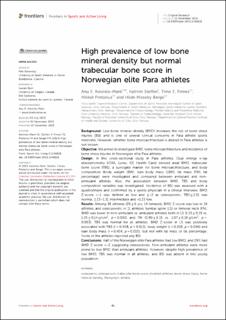High prevalence of low bone mineral density but normal trabecular bone score in Norwegian elite Para athletes
| dc.contributor.author | Koivisto-Mørk, Anu E. | |
| dc.contributor.author | Steffen, Kathrin | |
| dc.contributor.author | Finnes, Trine Elisabeth | |
| dc.contributor.author | Pretorius, Mikkel | |
| dc.contributor.author | Berge, Hilde Moseby | |
| dc.date.accessioned | 2024-01-05T08:53:01Z | |
| dc.date.available | 2024-01-05T08:53:01Z | |
| dc.date.created | 2023-11-17T15:28:57Z | |
| dc.date.issued | 2023 | |
| dc.identifier.citation | Frontiers in Sports and Active Living. 2023, 5, Artikkel 1246828. | en_US |
| dc.identifier.issn | 2624-9367 | |
| dc.identifier.uri | https://hdl.handle.net/11250/3110032 | |
| dc.description | This is an open-access article distributed under the terms of the Creative Commons Attribution License (CC BY). The use, distribution or reproduction in other forums is permitted, provided the original author(s) and the copyright owner(s) are credited and that the original publication in this journal is cited, in accordance with accepted academic practice. No use, distribution or reproduction is permitted which does not comply with these terms. | en_US |
| dc.description.abstract | Background: Low bone mineral density (BMD) increases the risk of bone stress injuries (BSI) and is one of several clinical concerns in Para athlete sports medicine. However, whether bone microarchitecture is altered in Para athletes is not known. Objective: We aimed to investigate BMD, bone microarchitecture and incidence of bone stress injuries in Norwegian elite Para athletes. Design: In this cross-sectional study in Para athletes, Dual energy x-ray absorptiometry (iDXA, Lunar, GE Health Care) derived areal BMD, trabecular bone score (TBS), a surrogate marker for bone microarchitecture, and body composition (body weight (BW), lean body mass (LBM), fat mass (FM), fat percentage) were investigated and compared between ambulant and non-ambulant athletes. Also, the association between BMD, TBS and body composition variables was investigated. Incidence of BSI was assessed with a questionnaire and confirmed by a sports physician in a clinical interview. BMD Z-score <−1 was defined as low and ≤−2 as osteoporotic. TBS ≥ 1.31 was normal, 1.23–1.31 intermediate and <1.23 low. Results: Among 38 athletes (26 ± 6 yrs, 14 females), BMD Z-score was low in 19 athletes, and osteoporotic in 11 athletes' lumbar spine (LS) or femoral neck (FN). BMD was lower in non-ambulant vs. ambulant athletes both in LS (1.13 ± 0.19 vs. 1.25 ± 0.14 g/cm2, p = 0.030) and FN (0.90 ± 0.15 vs. 1.07 ± 0.16 g/cm2, p = 0.003). TBS was normal for all athletes. BMD Z-score in LS was positively associated with TBS (r = 0.408, p = 0.013), body weight (r = 0.326, p = 0.046) and lean body mass (r = 0.414, p = 0.010), but not with fat mass or fat percentage. None of the athletes reported any BSI. Conclusions: Half of the Norwegian elite Para athletes had low BMD, and 29% had BMD Z-score <−2 suggesting osteoporosis. Non-ambulant athletes were more prone to low BMD than ambulant athletes. However, despite high prevalence of low BMD, TBS was normal in all athletes, and BSI was absent in this young population. | en_US |
| dc.language.iso | eng | en_US |
| dc.subject | bone mineral density | en_US |
| dc.subject | bone stress injury | en_US |
| dc.subject | disabled athletes | en_US |
| dc.subject | osteopenia | en_US |
| dc.subject | osteoporosis | en_US |
| dc.subject | Paralympic athlete | en_US |
| dc.subject | trabecular bone score | en_US |
| dc.title | High prevalence of low bone mineral density but normal trabecular bone score in Norwegian elite Para athletes | en_US |
| dc.type | Peer reviewed | en_US |
| dc.type | Journal article | en_US |
| dc.description.version | publishedVersion | en_US |
| dc.rights.holder | © 2023 Koivisto-Mørk, Steffen, Finnes, Pretorius and Berge | en_US |
| dc.source.pagenumber | 10 | en_US |
| dc.source.volume | 5 | en_US |
| dc.source.journal | Frontiers in Sports and Active Living | en_US |
| dc.identifier.doi | 10.3389/fspor.2023.1246828 | |
| dc.identifier.cristin | 2198258 | |
| dc.description.localcode | Institutt for idrettsmedisinske fag / Department of Sports Medicine | en_US |
| dc.source.articlenumber | 1246828 | en_US |
| cristin.ispublished | true | |
| cristin.fulltext | original | |
| cristin.qualitycode | 1 |
Tilhørende fil(er)
Denne innførselen finnes i følgende samling(er)
-
Artikler / Articles [2097]
-
Publikasjoner fra Cristin [1085]


